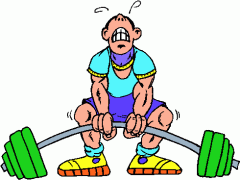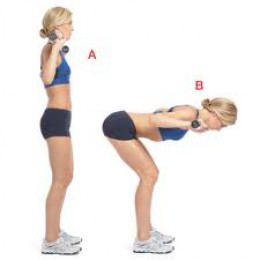 If you have never used weights, stepping into a weight room can be scary. Similarly, if you have been away from working out for a while, figuring out where to start can also be a daunting task. Today, I will give you a simple workout for getting started.
If you have never used weights, stepping into a weight room can be scary. Similarly, if you have been away from working out for a while, figuring out where to start can also be a daunting task. Today, I will give you a simple workout for getting started.
There are a few things you need to know before starting a good workout routine. Correct form, muscle reaction, intervals, and rest periods are key parts to being successful in the weight room. How these four things will fit into your routine depend on the goal you are reaching for, but a general knowledge will help you get started.
Correct form is THE MOST IMPORTANT thing you can learn. Crossfit Athletic Center says proper form will help you “prevent injuries, use your energy effectively, use the right muscles, and make sure your workout is effective.” For the workout this week there will be three exercises:
The videos for the exercises give a pretty good idea how to correctly perform each exercise. The guys in the video are using some serious weight but this is not for everyone. Start with a weight you can handle.
Muscle Reaction is about getting your muscles to react the way you want. If your goal is not to get bigger, but to slim down and tone up, then there is a specific type of weight and number of reps you should be performing. A quick guide:
- To tone muscle and burn fat, aim for 3 sets of 15 to 20 reps. Make sure the weight is enough that completely finishing set 3 is difficult.
- To add muscle size, aim for 4 to 5 sets of 8 to 12 reps. Again, make sure the weight is enough that the last set is difficult to completely finish.
- To add strength, aim for 6 sets of 5 or less reps. One more time, make sure the weight is enough that the last set is difficult to finish.
- Last note: do your best to make sure your form is correct!
Intervals are another very important part to reaching your goals. Myth 1 is about not doing too much cardio. In that post I show that using cardio in conjunction with weights is the best solution. Intervals are one way to add cardio back to your workout. So what are intervals?
There are many different choices: shadowboxing, jogging in place, hitting a punching bag, ab exercises, treadmill etc. These intervals are meant to be something that involves very light or no weight. They get your heart rate up and keep your body in a state of flux. How do you use them in your workout?
You will see an example in the workout at the end, but they get placed in the workout between each set or group of sets.
Rest Periods are also very important. Your muscles will not be able to push through a workout for 30 minutes without short rest periods. For most workouts these should be limited to no more than 60 seconds between sets. The purpose is to give muscles a chance to recover between sets.
Bodybuilding.com explains that for each type of athlete the rest necessary between sets can vary. For strength athletes they recommend 3 to 5 minutes. For muscle growth and endurance athletes they recommend 30 to 60 seconds. Again, it all depends on the goal you are trying to reach.
The Workout:
Monday:
- Bench Press 3 sets x 15 reps, or 4 sets x 10 reps, or 6 sets x 4 reps depending on goal.
- Between each set use a cardio interval like shadowboxing.
- If you don’t know, shadowboxing is punching at the air or your shadow on the wall. Don’t actually punch the wall. Do it for 30 seconds each time.
Tuesday:
- 30 minutes of cardio.
- Get outside and walk, go for a jog, or get on a bike or treadmill at the gym.
Wednesday:
- Squat 3 sets x 15 reps, or 4 sets x 10 reps, or 6 sets x 4 reps depending on goal.
- Use a cardio interval between each set like an ab exercise. Go for 30 reps each set.
Thursday:
- 30 minutes of cardio.
- Get outside and walk, go for a jog, or get on a bike or treadmill at the gym.
Friday:
- Deadlift 3 sets x 15 reps, or 4 sets x 10 reps, or 6 sets x 4 reps depending on goal.
- Use a cardio interval between each set like jogging in place. Do it for 30 seconds each set.
Saturday and Sunday:
Next Time: Myth 3, The More I Workout, The More Progress I Am Making








